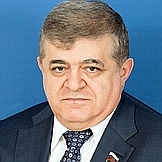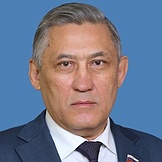Regional flags and emblems


PROFILE
Established 7 May 1934
Capital Birobidzhan
The Jewish Autonomous Region is part of the Far Eastern Federal District
Area 36,300 sq km
Population 144 400 (2025)
Ethnic groups
(2020 National Census, %)
Russian – 95,67
Other – 4,33
Administrative divisions (2024)
Municipal districts – 5
City districts – 1
Rural towns – 10
Rural districts – 17
Geography and climate
The autonomous region is located in the Amur Region. There are the Maly Khingan and Bureinsky ranges (up to 1,209 m high) in the northwest and north, and the Middle Amur lowland in the southeast.
The autonomous region borders the Khabarovsk Territory and the Amur Region and also has the state border with China along the Amur River.
The climate is temperate monsoon. The average temperature is −26.4°C in January and 17.7°C in July. The average precipitation is 8 mm in January and 173 mm in July.
The autonomous region is home to the Bastak State Nature Reserve, six regional nature sanctuaries and an arboretum.
Government
The legislative branch is represented by the Legislative Assembly of the Jewish Autonomous Region, which is the permanent, supreme and only body of legislative authority in the autonomous region.
The region’s Legislative Assembly has 19 deputies elected for five years, nine of them running in single-mandate constituencies and the other ten elected in the single electoral district under the proportional representation system.
The current Legislative Assembly legislature was elected in September 2021. Its term expires in September 2026.
The executive branch in the Jewish Autonomous Region is represented by the Governor, the regional Government which he heads and other executive bodies established by the regional Government. The Government of the Jewish Autonomous Region is the supreme, permanent body of executive authority in the region.
The Governor of the Jewish Autonomous Region is the region’s highest-ranking official and is elected for five years by Russian citizens who permanently reside in the region. The term of office of the Acting Governor – until the person elected Governor of the Jewish Autonomous Region takes office.
Economy and natural resources
Industrial output accounts for about 19% of the regional GDP.
The downstream sector is represented by ferrous and non-ferrous metallurgy, the construction materials industry, timber and woodworking industry as well as the food industry.
The upstream sector is carried out on the basis of explored deposits of placer gold, tin, iron, manganese, magnesite, brucite, graphite, limestone and dolomite, phosphate rock, mineral paints, natural facing stone, expanded clay raw materials, lignite and peat.
Major companies operating in the Jewish Autonomous Region include Teploozersky Cement Plant, Kimkan and Sutara Mining and Processing Factory, and Viktoria Birobidzhan Textile Manufacturing and Trading Company.
The production and distribution of electricity, gas and water is carried out on the basis of the energy complex represented by thermal power stations and heat and electricity stations. Natural gas is expected to be supplied to the region through the Power of Siberia pipeline (Yakutia – Khabarovsk – Vladivostok), currently under construction. More than 300 km of the pipeline will be located within the Jewish Autonomous Region.
Agriculture accounts for over 3% of the regional GDP. The crop cultures for the region are wheat, soybeans, potatoes and vegetables; in livestock − the production of meat and milk. The largest agricultural companies are Agro Green Business, Agro-Soya, Birobidzhan Meat Factory Agricultural Holding.
Construction accounts for about 9% of the regional GDP, another 18% of the regional GDP go to transport and communications, while wholesale and retail trade take up another 8% of the regional GDP.
Culture and tourism
Volochaevskaya Sopka Museum is a major cultural and historical attraction of the Jewish Autonomous Region. It is devoted to the Battle of Volochayevka, an important battle in the Russian Civil War.
The main tourist attractions of Birobidzhan are River Bira, monument to Sholom Aleichem and a museum named after him. The museum has an area devoted to nature, as well as sections on the Russian Civil War and the Great Patriotic War, together with the history of the region, its creation and development. In the city centre, there is a regional fine arts museum with a rich collection of Old Testament paintings by contemporary artists. Near the railway station on the square there is a sculptural composition dedicated to the first settlers depicting people in a horse wagon.
Despite it not being very big in size, the region has two types of terrain: mountain terrain and the plains. Conservation areas cover a surface of more than 300,000 hectares. For speleology enthusiasts there are solutional caves in the Obluchensky and Oktyabrsky districts with tourist routes. Visitors are especially attracted by the Stary Medved (Old Bear) cave where centuries-old ice does not melt even when it’s 32°С outside.
There are a number of mineral springs in the region. A health resort was created in Kuldur village around one of the most famous thermal springs where water contains aluminum, iron, manganese, titanium, chrome, copper, silver, chlorine, lithium, barium, strontium and fluorine.
One of the longest tourist routes in the region lies along the Amur River offering an opportunity to discover natural sites, including the Medvezhiy (Bear) Rock with its unique cliff vegetation, Gomel Mountain and Kazachiy Sad, catch fish and explore the unique flora of Vetroparshikha Bay, see lakes Manzhurka, Utinoye and Lebedinoe, visit cedar plantations in Dichun Reserve, and archaeological sites at the ancient settlements of the Mohe people.


